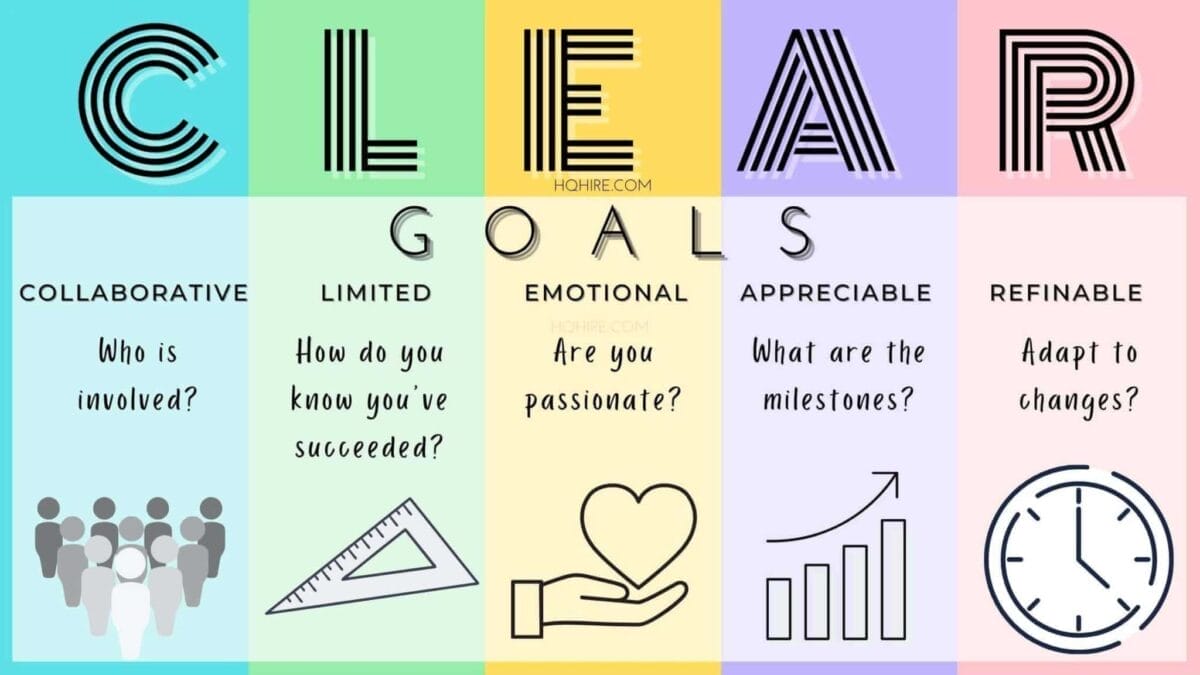How to set goals that are clear and achievable?
Whether you’re a new employee who just started your career, or an experienced employee climbing the corporate ladder. You’ve probably tried many different goal-setting metrologies to set daily job and career goals.
Many people made the mistake of setting goals that are too ambitious, or unclear making them almost impossible to achieve. Setting realistic goals is the key to success.
If you want to achieve the goals that you’ve set, just follow this advice.
Set CLEAR, realistic goals that helps you to think clearly and deeply into the scope of the goal.
CLEAR Goal is a goal-setting strategy to break your long-term goals into small, achievable, and actionable steps. Achieving multiple goals along your way gives you a sense of accomplishment and motivates you forward.
CLEAR is the acronym that stands for Collaborative, Limited, Emotional, Appreciable, Refinable.

Recommendations: Goals to achieve during your first year at a new job!
How to Write CLEAR Goals?
When writing CLEAR goals, there are 5 things to consider.
- Collaborative: Goals are achieved in collaboration with the help of others, especially in human society, where we live in a big community.
- Limited: Set a limit to your goal’s duration and scope so that it can be clear and achievable.
- Emotional: Emotions often control what we do or how we perform a task. Consider how the goal can connect with the employees and tap into their energy and passion.
- Appreciable: Break down large goals into smaller actionable goals so that they can be accomplished easily and quickly. Take small but continuous steps towards achieving the final goal.
- Refinable: Set goals with a clear objective, but as situations arise, refine and modify your goals accordingly.
Collaborative
The collaboration will allow employees to work together by contributing their unique skills and expertise to help meet the objectives.
Each member of the team will achieve their individual goals which together will result in bigger accomplishments.
Questions to ask:
- Who is on your team?
- Who are your stakeholders, customers, and counterparts?
- Who do you need support from in order to achieve this?
- Who will benefit from achieving this goal?
- Who will be willing to support you?
In a collaborative society, we cannot do everything ourselves.
We need to seek out collaboration with the right people if we want to achieve our goals.
This is especially true if you are setting up a project management team.
Understanding who to collaborate with and who to be in your team will be the first step to succeed in your goal.
Limited
Limiting the duration and scope of your goal will allow you to set clear and achievable goals.
With this, you will be able to set the limit in terms of duration and difficulty on your set goals.
With a target endpoint and a realistically achievable goal in mind, it will motivate you to work towards the goal.
Questions to ask:
- When do you start and work on it?
- When do you need to accomplish the task?
- What is the time limit of this goal?
- What is the geographical limit?
- What are the financial targets of this goal?
- Are there do’s and don’t when achieving this goal?
- How do I know when the goal is achieved?
Set a limit that is clear and realistic.
Limit the depth of your goal to a level where it is achievable.
Limit your duration so that you won’t procrastinate.
Emotional
Set goals that make an undeniable emotional connection with you and your core team. The goal should tap into the energy and passion.
Employees are excited by the prospect of accomplishing their goals when they work on things that they enjoy and are good at.
Emotions create actions,
Actions create results.
Questions to ask:
- Will this goal align with my purpose?
- Why is this goal important?
- How passionate am I about fulfilling this goal?
- How will the goal affect the emotions of the people in my team?
- How passionate is my team about fulfilling this goal?
When anyone in the team has met the goal, the manager should always applaud them for a job well done, so they feel appreciated and get motivated for the next challenge.
Appreciable
Large goals should be broken down into smaller milestones. This small but important milestone prevents the employee working on these goals from feeling overwhelmed by large, long-term goals.
Question: “How do you eat an elephant?”
Answer: “A bite at a time.”
Questions to Ask:
- What is the next most obvious action?
- What are the key milestones of this goal?
- What other goals will be accomplished while working towards this final goal?
- What is the key performance indicator?
- How do I separate the key performance indicator into a few smaller milestones?
Breaking down large scary goals can help you in creating actionable steps.
Taking these steps can help you to achieve milestones, or small goals need to bring you closer to your final goal.
Question: “How do you earn a million dollar?”
Answer: “A dollar at a time.”
Refinable
Set goals that are clear, defined, but flexible enough to adapt to the new situation, or when new information arises. Be open to refining and modifying your goals when necessary.
Be agile.
Because no one will know what will happen in the future.
Questions to ask:
- What situation or new information may arise that leads to a change in the overall goal?
- How will I adapt to the best-case scenario?
- How will I adapt to the worst-case scenario?
- How will I adapt to the most likely scenario?
- When will this goal serve no purpose due to the change in the situation?
- When do I need to revisit the goal to tweet it to suit the change in needs?
By being agile and having an open mindset of welcoming surprises, you will ensure your goals will never become irrelevant in this ever-changing environment.
CLEAR Goals Examples
CLEAR goals can be used to set goals for many areas; personal finance goals, sales goals, or even career goals.
Here we have a few examples of how you can use the CLEAR goal setting technique to set your personal and professional goals.
Setting CLEAR goals for Retirement (Example)
“My wife and I will work together to achieve financial security for our retirement.
We will accomplish this by saving $1 million dollars by the age of 60.
We will save 20% of our salary each year and celebrate our success with every $100,000 dollar saved.
We will review our financial plan every 3 years so that we can be sure we are on our way to reaching our target.”
Setting CLEAR goals for Sales Target (Example)
“I will work with my clients and my team on each sale to reach our sales target.
I will achieve at least 20 sales every month, which will help achieve the team’s overall sales target and get the fat bonus for being the best sales team of the month.
To achieve this, I will close 5 deals every week and at least 1 deal every workday.
I will perform a periodic review on my sales target when there are changes to the company’s policy or product seasonal variation.”
Setting CLEAR goals for Project Completion (Example)
“I will work with my project team to ensure the successful completion of this qualification project.
We will complete at least 1 milestone every month and successfully complete the qualification project in 6 months’ time.
To achieve this, we will spend at least 30% of our time focusing on this project.
Every week, we will come together to review our progress and resolve any roadblock so that we may achieve our milestone and timely completion of the qualification project.”
Clear Goals vs SMART Goals
CLEAR Goals are the best goal-setting strategy for setting team objectives, or team goals. Setting CLEAR Goals in project management allows the leadership team to set realistic, actionable goals that can adapt and be agile when new information or situation arises.
SMART is the acronym for Specific, Measurable, Achievable, Relevant, and Timely. SMART Goal methodology is commonly used for setting both short-term and long-term goals that measure your outcome. Although SMART methodology can be used to set individual and team goals, SMART goals lack the agility to adapt to new information or situation.
Why CLEAR Goals might be better than SMART Goals?
CLEAR Goals are replacing SMART goals in many ways. In this ever-changing environment where there is always a constant new influx of information.
Setting CLEAR goals allows you to always adapt to the current situation and make the best decision that can move you closer to your goals.

Alternative to SMART Goals
Questions?
- Do you think CLEAR Goals are better than SMART Goals?
- Are you using the CLEAR Goals methodology for your team?
- What other alternatives to SMART Goals do you know about?
PS. Have you heard of FAST Goals, check this new alternative to SMART goals as well.
Up Next… How to write PACT Goals, another alternative to SMART Goals?
Read Also:
- +21 Best Types of Goal Setting Techniques (Succeeding at Work)
- Pomodoro Technique: Time Management Method to Boost Your Productivity
- Ultimate Guide to Hoshin Kanri (Policy Deployment) Strategic Planning (Step Guide)
- Management By Objectives (MBO) Goal Setting Model (Examples and Templates)
- OKR Framework: Ultimate Guide to Achieving Key Result & Goals (with Templates + Examples)
Join over 11,000+ achievers who are committed to achieving their career goals!






